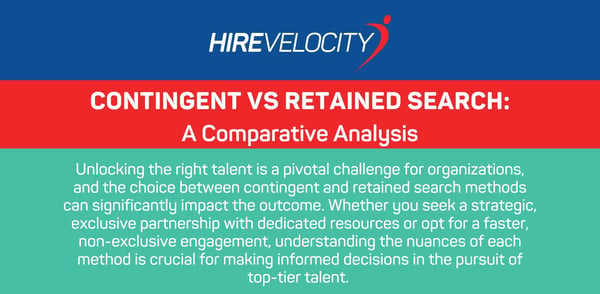
In the competitive landscape of talent acquisition, the choice between contingent and retained search firms can significantly impact the success of your hiring strategy. In this blog post, we delve into the nuances of Contingent vs. Retained Search, providing a detailed exploration of their differences and helping you understand which approach aligns better with your organizational needs.
Unpacking the Payment Structures
One of the key differentiators between contingent and retained search firms lies in their payment structures. When opting for a contingent search, clients incur no upfront fees. Instead, payment is contingent upon successfully placing a candidate, typically as a percentage of the candidate's first-year salary. This model can be enticing for organizations looking to minimize financial risk.
On the other hand, a retained search operates on a more structured payment plan. Upon signing the contract, clients commit to an upfront retainer fee, constituting the first third of the total cost. The second third is paid when the search firm submits candidate profiles, and the final installment is settled upon the successful hire of the candidate. This phased approach ensures ongoing client engagement throughout the search process, reflecting a shared commitment to success.
Exclusivity and Commitment Levels
In a contingent search, multiple firms may be engaged simultaneously as the client is under no exclusive commitment. This non-exclusive arrangement can result in a broader pool of candidates, but the quality may vary.
Contrastingly, a retained search establishes an exclusive partnership. This commitment ensures dedicated resources, priority attention, and a more strategic and thorough search process. It is often the preferred approach for executive-level and critical positions.
Quality of Candidates and Speed of Placement
The quality of candidates attracted is another critical factor. A retained search often draws higher-quality candidates due to its exclusive and committed nature. The comprehensive and strategic approach in retained searches aligns with attracting top-tier talent.
On the contrary, a contingent search may result in a larger candidate pool, but the emphasis is on a quicker placement. The trade-off is a potentially varied quality of candidates.
Download the Infographic for a Visual Breakdown
For a visual breakdown of the distinctions between contingent and retained search, download our infographic: Contingent vs Retained Search Firms: A Comparative Analysis. Gain insights into payment structures, commitment levels, candidate quality, and more to make informed decisions in your talent acquisition strategy.
Whether you are navigating the competitive landscape of contingent search or seeking the exclusivity of retained search, understanding these differences empowers you to make the right hiring decisions for your organization. Contact us to explore strategic solutions for securing top-tier executive talent.

